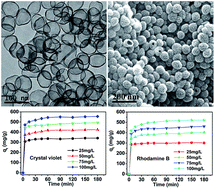Hydrophilic hollow carbon nanocapsules for high-capacity adsorptive removal of cationic dyes in aqueous systems†
Abstract
Hollow carbon nanocapsules (HCNs) are prepared via the decomposition and leaching of nickel carbide (Ni3C) nanoparticles. The leaching process renders the HCNs hydrophilic and improves their aqueous dispersibility through the formation of oxygen-containing functional groups on the surface. These functional groups, in conjunction with the graphitized shell of the HCNs, result in a high affinity for cationic dye species such as rhodamine B (RB) and crystal violet (CV) in aqueous solution. Adsorption experiments are performed to investigate the absorptive performance of the HCNs as a function of the initial dye concentration, contact time and temperature. The results confirm that the HCNs have both a high adsorption rate and a high maximum adsorption capacity for the considered organic dyes. Specifically, 85% of the maximum adsorption capacity is obtained within the first 5 minutes of adsorption and the maximum adsorption capacity at 333 K is 628.93 and 675.68 mg g−1 for RB and CV dyes, respectively.


 Please wait while we load your content...
Please wait while we load your content...